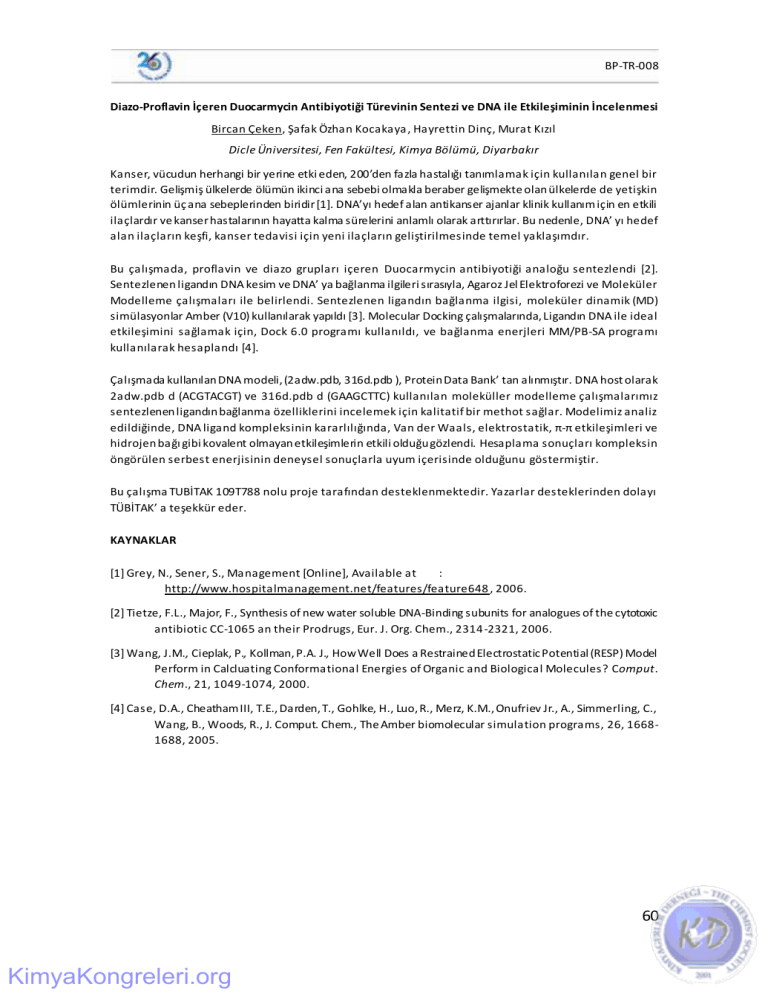
BP-TR-008
Diazo-Proflavin İçeren Duocarmycin Antibiyotiği Türevinin Sentezi ve DNA ile Etkileşiminin İncelenmesi
Bircan Çeken, Şafak Özhan Kocakaya, Hayrettin Dinç, Murat Kızıl
Dicle Üniversitesi, Fen Fakültesi, Kimya Bölümü, Diyarbakır
Kanser, vücudun herhangi bir yerine etki eden, 200’den fazla hastalığı tanımlamak için kullanılan genel bir
terimdir. Gelişmiş ülkelerde ölümün ikinci ana sebebi olmakla beraber gelişmekte olan ülkelerde de yetişkin
ölümlerinin üç ana sebeplerinden biridir [1]. DNA’yı hedef alan antikanser ajanlar klinik kullanım için en etkili
ilaçlardır ve kanser hastalarının hayatta kalma sürelerini anlamlı olarak arttırırlar. Bu nedenle, DNA’ yı hedef
alan ilaçların keşfi, kanser tedavisi için yeni ilaçların geliştirilmesinde temel yaklaşımdır.
Bu çalışmada, proflavin ve diazo grupları içeren Duocarmycin antibiyotiği analoğu sentezlendi [2].
Sentezlenen ligandın DNA kesim ve DNA’ ya bağlanma ilgileri sırasıyla, Agaroz Jel Elektroforezi ve Moleküler
Modelleme çalışmaları ile belirlendi. Sentezlenen ligandın bağlanma ilgisi, moleküler dinamik (MD)
simülasyonlar Amber (V10) kullanılarak yapıldı [3]. Molecular Docking çalışmalarında, Ligandın DNA ile ideal
etkileşimini sağlamak için, Dock 6.0 programı kullanıldı, ve bağlanma enerjleri MM/PB-SA programı
kullanılarak hesaplandı [4].
Çalışmada kullanılan DNA modeli, (2adw.pdb, 316d.pdb ), Protein Data Bank’ tan alınmıştır. DNA host olarak
2adw.pdb d (ACGTACGT) ve 316d.pdb d (GAAGCTTC) kullanılan moleküller modelleme çalışmalarımız
sentezlenen ligandın bağlanma özelliklerini incelemek için kalitatif bir methot sağlar. Modelimiz analiz
edildiğinde, DNA ligand kompleksinin kararlılığında, Van der Waals, elektrostatik, π-π etkileşimleri ve
hidrojen bağı gibi kovalent olmayan etkileşimlerin etkili olduğu gözlendi. Hesaplama sonuçları kompleksin
öngörülen serbest enerjisinin deneysel sonuçlarla uyum içerisinde olduğunu göstermiştir.
Bu çalışma TUBİTAK 109T788 nolu proje tarafından desteklenmektedir. Yazarlar desteklerinden dolayı
TÜBİTAK’ a teşekkür eder.
KAYNAKLAR
[1] Grey, N., Sener, S., Management [Online], Available at
:
http://www.hospitalmanagement.net/features/feature648 , 2006.
[2] Tietze, F.L., Major, F., Synthesis of new water soluble DNA-Binding subunits for analogues of the cytotoxic
antibiotic CC-1065 an their Prodrugs, Eur. J. Org. Chem., 2314 -2321, 2006.
[3] Wang, J.M., Cieplak, P., Kollman, P.A. J., How Well Does a Restrained Electrostatic Potential (RESP) Model
Perform in Calcluating Conformational Energies of Organic and Biological Molecules? Comput.
Chem., 21, 1049-1074, 2000.
[4] Case, D.A., Cheatham III, T.E., Darden, T., Gohlke, H., Luo, R., Merz, K.M., Onufriev Jr., A., Simmerling, C.,
Wang, B., Woods, R., J. Comput. Chem., The Amber biomolecular simulation programs, 26, 16681688, 2005.
60
KimyaKongreleri.org
BP-EN-008
Synthesis and DNA-Interaction of Duocarmycin Antibiotic Derivative Containing Diazo-Proflavin
Bircan Çeken, Şafak Özhan Kocakaya, Hayrettin Dinç, Murat Kızıl
Dicle University, Faculty of Science, Chemistry Department, Diyarbakır, Turkey
Cancer is a general term that is used to describe a group of more than 200 diseases, which can affect any
part of the body. It is the second leading cause of death in developed countries and is one of the three
leading causes of death for adults in developing countries [1]. Anticancer agents that target DNA are among
the most effective in clinical use and have produced significant increases in the survival of patients with
cancer. Consequently, the discovery of new drugs that target DNA is a major line of approach for the
development of new drugs for the treatment of cancer.
In this study, Duocarmycin antibiotic analog containing proflavin and diazo group was synthesized [2]. The
DNA cleavage and binding affinity of synthesized ligand was investigated using Agarose Jel Electrophoresis
and Molecular modeling studies, respectively. The DNA binding affinity of synthesized ligand was
investigated by molecular dynamics (MD) simulations with the Amber (V10 ). Molecular docking studies
were performed with the Dock 6.0 to afford the ideal interaction mode of the ligands into the binding site of
the DNA [3] and the binding energies calculated by MM/PB-SA [4].
The DNA model used in this study were taken from the Protein Data Bank (2adw.pdb, 316d.pdb ). Our
molecular modeling approach, using the 2adw.pdb d (ACGTACGT) and 316d.pdb d (GAAGCTTC) as a model
DNA host, provides a qualitative method for comparing the binding properties of synthesized ligand. From
the analysis of our model it appears that noncovalent interactions likes, Van der Waals, electrostatic, π-π
interactions and hydrogen bonds are involved in stabilizing the DNA ligand complexes. In conclusion, the
calculation results show that the predicted free energies of the complex are well consistent with the
experimental data.
The authors would like to give thanks to TÜBITAK “The Scientific and Technical Research Council of Turkey”
for financial support under Project Number 109T788.
REFERENCES
[1] Grey, N., Sener, S., Management [Online]. Available at:
http://www.hospitalmanagement.net/features/feature648 , 2006.
[2] Tietze, F.L., Major, F., Synthesis of new water soluble DNA-Binding subunits for analogues of the cytotoxic
antibiotic CC-1065 an their Prodrugs, Eur. J. Org. Chem., 2314 -2321, 2006.
[3] Wang, J.M., Cieplak, P., Kollman, P.A. J., How Well Does a Restrained Electrostatic Potential (RESP) Model
Perform in Calcluating Conformational Energies of Organic and Biological Molecules? Comput.
Chem., 21, 1049-1074, 2000.
[4] Case, D.A., Cheatham III, T.E., Darden, T., Gohlke, H., Luo, R., Merz, K.M., Onufriev Jr., A., Simmerling, C.,
Wang, B., Woods, R., J. Comput. Chem., The Amber biomolecular simulation programs, 26, 16681688, 2005.
61
KimyaKongreleri.org
